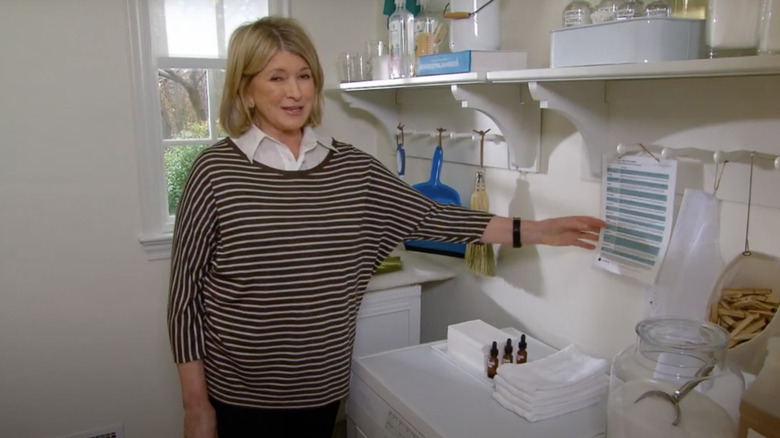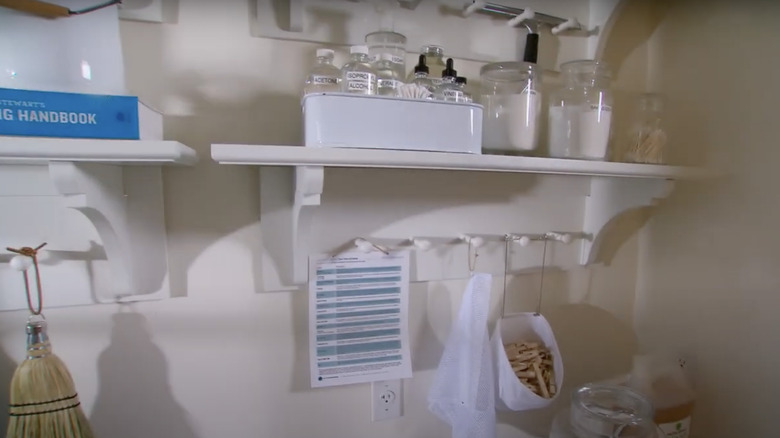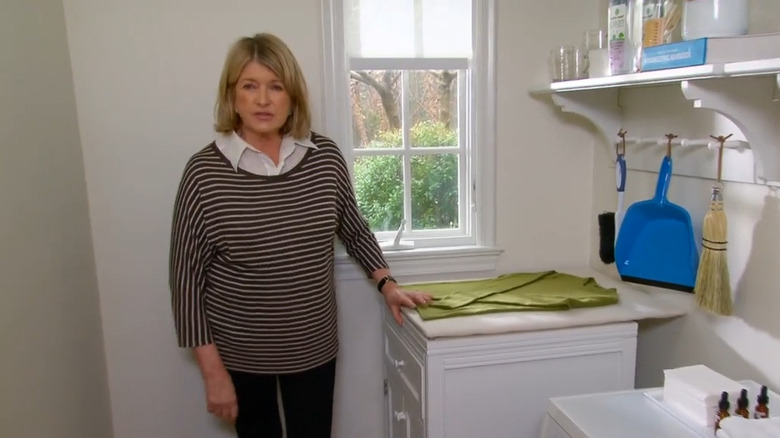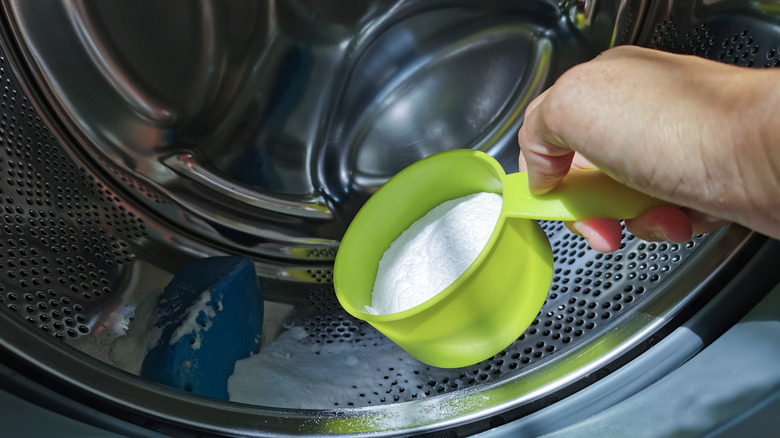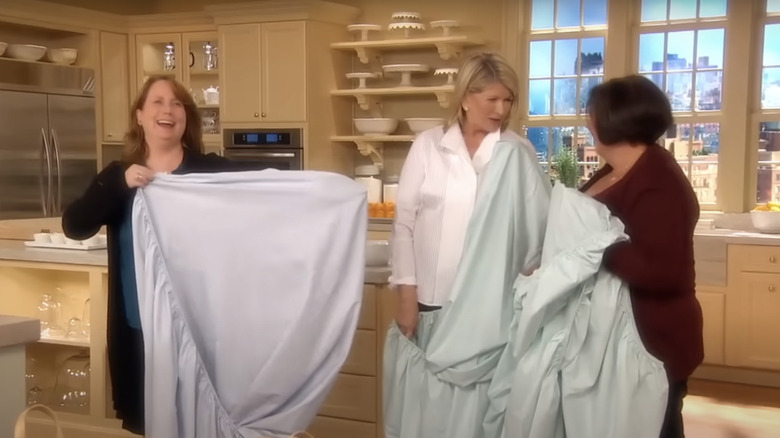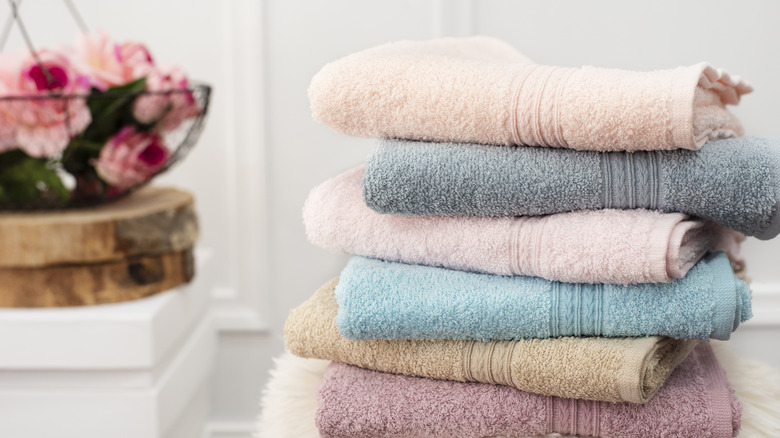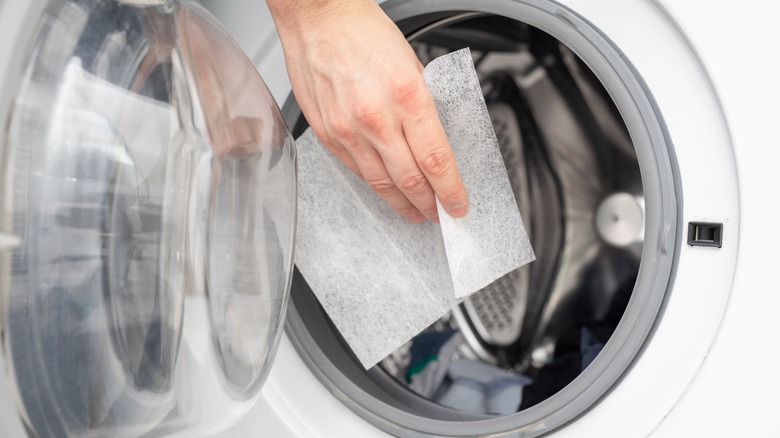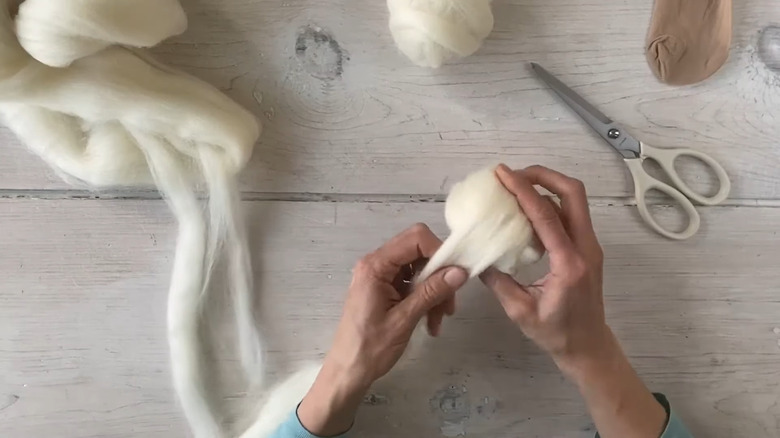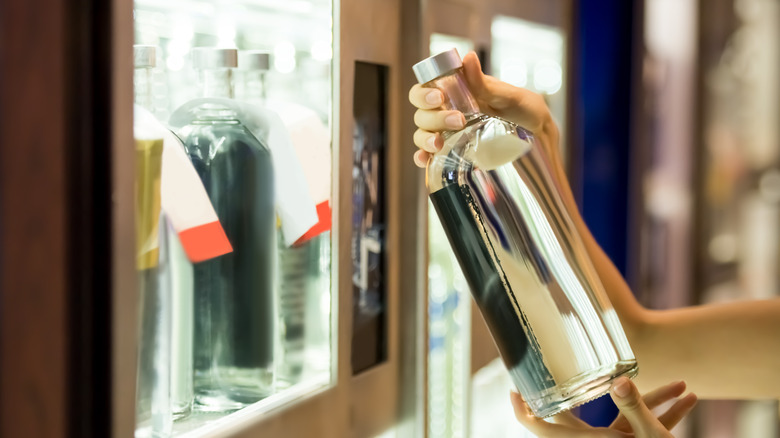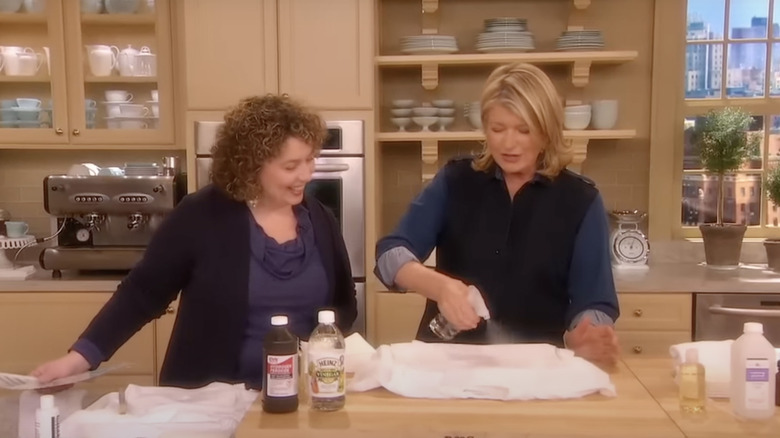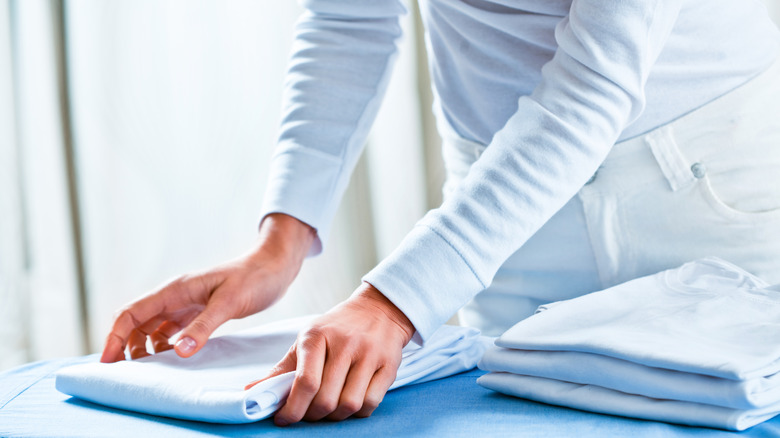Creative Laundry Room Hacks Martha Stewart Swears By
Laundry is a chore that truly seems never-ending, but luckily Martha Stewart knows a thing or two about making it easier. The home and gardening icon's career spans decades. So, when Stewart tells you a laundry room hack, you can trust that it'll work out as intended. Her years of experience remove almost any need for troubleshooting. Because what Martha says, goes. The main theme behind all of her advice is to make doing laundry less painful — and she has plenty of ways to help make that happen.
"I suggest that you revisit your laundry room's design and make alterations that will indeed turn the frequent tasks of washing, ironing, steaming, and folding into more of a pleasure and less of a chore," she wrote for CNN. "You may even opt for a brand-new redesign." Whatever you may choose, be it creating a brand-new laundry room, adding a handy stain-remover chart, or even finally understanding how to fold a fitted sheet — the home guru has you covered. These are the essential laundry room tips Stewart swears by.
Keep the essentials in your laundry room
A well-stocked laundry room will make the chore easier. According to Stewart, there are a few things to have on hand ahead of time to reduce the stress of the task when it's time to begin. "Always keep a stain removal chart...right in your laundry room," she told viewers on YouTube. "Keep a little kit with all the ingredients, the alcohol, the acetone, the vinegar, the mineral oil. All of these items will help you remove any tough stains. Just follow the directions on the chart."
The star offers fans a handy stain-removal chart on her website. However, you can also make your own chart with the toughest laundry stains you tend to encounter the most. This way, the laundry experience is most personalized and you're not skimming over information you never use each time you do a load.
Yet stain removal essentials aren't the only thing that Stewart keeps on hand. "I have a complete set of cleaning and washing and ironing tools and supplies, a good folding table, and excellent sturdy shelving to hold heavier items like soap canisters, cleaning kits, and even extra towels and linens," she wrote for CNN about the contents of her laundry room. From pre-treatment to putting laundry away, having the supplies prepared (and in a dedicated spot!) will keep your house running smoothly.
Shelves make things so much easier
Something holding you back from an easy, efficient time doing laundry could be the storage situation you have going on in the room. When you are loading the washer or dryer, things are going smoothly. But, as soon as you need a surface to fold clothes on, you don't have one because everything is covered in detergents, laundry sheets, and even piles of clean linen. "How do I make my small laundry room more functional?" Stewart asked viewers on YouTube. "You can greatly expand the usability of your space by just installing some of these great shelving units."
Stewart notes that units meant for entryways tend to work best as they are already designed for tighter spaces. Her solution is shelves installed at about eye level with two important features: a smooth, deep top to set things on and hooks underneath to hang a broom and dustpan, clothing pins, and other items. Having shelves that don't take up too much room, but still leave you plenty of space to store the essentials are the best.
Smaller ironing boards are a possibility for tiny laundry rooms
If you live in an apartment or have a house with a tiny laundry space, you might think that you simply don't have the means to iron your clothing. However, Stewart has the perfect solution to save you from your wrinkled fabrics. "This little rubber-footed ironing board is really a handy thing to have in a laundry room," she mentioned on YouTube, motioning to the mini board. "And, it fits right on top of this cabinet and it expands my table space."
While you can certainly purchase a smaller ironing board to use on the countertop (or washing machine top, if needed!) you can also build your own if you're feeling a bit more DIY-inclined. "Use a piece of plywood, whatever size you need,' she said during the Today Show segment. "Get them to cut it for you at The Home Depot or wherever you get your wood." From here, staple felt, bump (a fluffy middle layer to give the board padding), and muslin tautly around the wooden frame (in that order, so muslin should be on the outside). Then voila, you've made your own ironing board.
Baking soda is one of the most versatile ingredients out there
If there is one thing you need to have in your laundry room, Martha Stewart reckons it's baking soda. Addressing fans in a tongue in cheek advertisement for the brand Arm & Hammer, Stewart was quick to co-sign the ingredient's many benefits. "This laundry, it needs an extra boost. Arm & Hammer baking soda helps get it done," she playfully rapped on YouTube. "Add it with your laundry, it works for everyone. Fresh sheets, fresh towels, and linens for sure!"
This fresh smell is because of the chemicals in baking soda. The powder is alkaline, so when it mixes with stinky acidic smells, the resulting reaction forms an odorless, neutral substance. You can sprinkle a scoop of baking soda directly onto your fabrics in the wash. It doesn't matter if you have a top or front loader; it works the same. "Put it in the rinse cycle, get it smelling pure," Stewart continued.
But once the laundry is washed and dried, the power of baking soda doesn't stop. You can punch out the perforated sides of the box and store it in your linen closet to keep unused items fresh for longer. "The closet, the hamper — can collect a stale smell. Put a box in both places all will be well clean, fresh and bright," Stewart rapped.
Folding a fitted sheet doesn't have to be difficult
Folding a fitted sheet has got to be the bane of every launderer. No matter how hard you try, the finished job never seems to look as sleek as its flat sheet cousins. In fact, most of the fitted sheets in your closet are probably stacked up as shapeless blobs. It's so difficult, in fact, that even Martha struggled to master it. "The trick of the trade is getting all your corners folded up on themselves," Hosanna, a guest expert on Martha Stewart's show, said while demonstrating to Martha how it's done, via YouTube.
While there is a dedicated hack to keep the corners together to avoid a jumbled mess, it was so frustrating that the volunteer from the audience had to swap sheets with Martha to avoid embarrassment. This exchange led the host to give the audience a more realistic piece of fitted sheet advice "For all of you who are fitted-sheet impaired," Stewart declared, "I suggest that you wash your sheets, dry them, and put them right back on the bed."
Keep towels fluffy with proper care
There are a few things you need to do to keep your towels in the best shape for as long as you can. "Proper care from the outset keeps towels soft longer," Stewart wrote for CNN. Her first tip is something that might seem counterintuitive: No more fabric softener! "Stay away from fabric softener— it actually reduces absorbency," she wrote. This is because an abundance of the product won't be able to completely rinse out in the wash. Over time, this coats the fibers of the towels and can cause them to become less effective.
The star had another tip about laundry cleansers, warning readers to, "avoid using chlorine bleach on white towels, which can be damaging." Instead, reach for oxygen bleach like OxiClean which is good at removing odors and stains, just not as harsh. This won't break down your towels and will keep them nice for years to come.
Once the towels are freshly washed, Stewart still had a few more tips for longevity. She recommends drying them on medium heat, instead of the higher settings, to avoid damage. Once dry, fold them right away to avoid creating a pile of mess. Towels fold quickly and take up significantly less space once you've done so.
Scent your own fabric sheets to stay chemical-free
Fabric sheets are a great way to take the static out of your load of laundry. They work best on cotton clothing, but you should avoid mixing them with microfibers and towels, as they don't work as well. In addition to reducing static, these sheets also have substances on them to make fabrics feel softer and smell better. However, since they are artificially scented, you might choose to avoid using them at home. Whether you are allergic, or just trying to avoid chemicals, Stewart has a great middle ground.
"So, these fabric softener sheets, these are unscented," she told her audience on YouTube, holding one of them. However, if you still want to have a scent, "You can add a little bit of essential oil to a sheet like this. A little lavender oil, maybe eucalyptus if that's what you prefer, or a little bit of tangerine oil. This really smells very good." It's important not to douse the sheet in oil, but rather just give it a few drops in its center. This way your laundry will smell nice, but it won't be too overpowering.
You can DIY dryer balls with wool at home
If you don't want to use dryer sheets, another option is wool balls, which are the perfect DIY-project. Just like sheets, these woolen balls help prevent static. Plus, they also help your clothes dry a bit faster by creating space in between items, so the air can really fluff things up. They are also an easy way to make your home more eco-friendly, as they are not single use. Stewart's YouTube video demos the handmade process starting by winding a thick strand of wool roving back on itself to create a tight ball. The end result should be roughly the size of a tennis ball.
When finished, snip the wool from the spool and tuck the end in on itself. Next, take a pair of nylon tights, and cut the leg off. Place the balls into the stocking, one by one. Tie a knot after each ball is dropped to keep them separate. Place the filled stocking into the washing machine and run the load on the hottest setting. When drying them, medium heat is fine. When dry, you can cut them out of the stocking. The balls should be compacted thanks to the process. Finally, add a few drops of your favorite essential oil to make them smell nice.
Use vodka to deodorize items you can't wash
Sometimes things that stink are too bulky or oddly shaped to go into the washing machine. Luckily, Stewart has the perfect solution for these awkward moments. In a cheeky Dry January collaboration with Tito's Vodka, the famous homemaker is shown using the vodka in a spray bottle, spritzing things around the house to take the odor away. "Say goodbye to musty smells," she said on Instagram, while spraying a pair of stinky boots in her entryway.
And, while the collaboration is meant to be a bit silly, the clever laundry tip suggested in the ad actually does work. For the best results, be sure to use clear, unflavored vodka so you don't make anything sticky while trying to get it clean. The higher the alcohol percentage the better as well, as this means the vodka will be stronger and better at eliminating smells. Just pour the liquid into a spray bottle and spritz it onto anything that needs a refresh. Don't mix it with anything to dilute it, either. It's great for stuffed animals, curtains, shoes, and even upholstered furniture. Just be sure to label the bottle and keep it stored safely away from anyone curious and underage.
Diluted dish soap is a great pre-wash
Getting stains out is one of the great mysteries of the laundry room. And while pre-treating them is always a great first step to success, it's sometimes hard to know what to use. Sure, there are pre-formulated mixtures you can buy from nearly every popular brand. Yet Stewart has an easier option, or something to reach for when you are low on supplies in between shopping trips. When you are faced with a tough stain, take your favorite dishwashing liquid, mix it in a spray bottle with tap water, and keep it in your laundry room arsenal. "What you do is spray it first with a diluted dish detergent," she told viewers on YouTube while demonstrating the hack. "This works very well."
The key is to nearly saturate the material. Don't be shy when spraying it, it should be pretty wet, so there is plenty of soap available to start breaking down the stain. After letting it sit, blot the stain with a clean cloth. From there, you can rinse with vinegar, pat that down, then pop in into the wash with a little bit of enzyme detergent.
There actually is a correct way to fold a t-shirt
Folding laundry properly can be such a hassle, but Stewart has a hack to make folding t-shirts just a little bit easier. In fact, she's almost got it town to a science. To start, lay the shirt on its back, with the collar near your left hand. Pinch the fabric about a third of the way between the neck and the right sleeve. Next, find a point about three inches down from the arm hole, straight down from the first point. Pinch both points. "Now take your left hand and take it down, right down to that imaginary line," Stewart instructed her audience on YouTube, folding the shirt in half. Next is the tricky part, but once you master it, folding shirts will be a breeze. You have to untwist your hands without letting go of the fabric.
Lift the shirt up off the surface you're folding it on and shake it out. You should be holding a perfect rectangle of fabric. When set back down and folded in half, you then end up with a smooth, perfectly folding shirt. These are easy to stack in vertically in your drawers, saving you lots of space.

